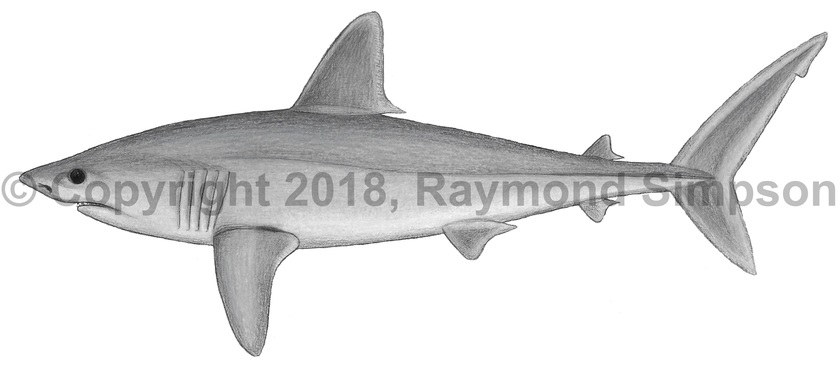
Common Name
Porbeagle
Year Described
Bonnaterre, 1788
Identification
Upper jaw: 22-31 rows
Lower jaw: 24-29 rows
A large, stocky and robust shark. Snout relatively long and pointed. Eye very large. Nostrils midway between mouth and snout tip. Mouth wide and curved. Labial furrows distinct. Teeth narrow and asymmetrical with smooth edges and small lateral cusps. Gill slits number five and are long (1/2 of body depth). Posterior two slits compressed together before pectoral fin base. Body tapering posteriorly. Caudal peduncle much wider than tall with a high lateral keel and prominent secondary keels. First dorsal fin origin over free rear tip of pectoral fin. D1 convex on rear edge. Second dorsal fin tiny. Pectoral fin large and falcate with a concave rear margin. Pelvic fin larger than D2 and far behind level of D1. Anal fin about the size of D2 and originates immediately below D2. Caudal fin with precaudal pits above and below. Caudal fin lunate with a long lower lobe and a small notch on upper lobe.
Color
Dorsum steel gray, brown-gray or blue-gray, becoming abruptly gray on flanks and whitish on belly. No markings on body or fins. Rear tips of fins white. Rest of fins body colored. Eye black.
Size
Mature adults from 195-245cm TL. Maximum size possibly over 350cm TL. Juveniles at least 60cm TL. Females average larger than males.
Habitat
Found in cold temperate waters from the surface to over 1800m. It is both coastal and pelagic. Mostly feeds on fish and squids.
Range
Greenland to North Carolina, but mostly north of New Jersey. Also disjunct in the south Atlantic from S. Brazil to Argentina.
References
Castro, J.I. 2011. The Sharks of North America. Oxford University Press, 640 pp.
Ebert, D. A., & M. Dando. 2020. Field Guide to Sharks, Rays & Chimaeras of Europe and the Mediterranean. Princeton University Press. 2020.
Other Notes
More study is needed to determine if the southern hemisphere population is a distinct species because there is no connectivity between the two disjunct populations. This species is closely related to the North Pacific Lamna ditropis. Separate N. Pacific, N. Atlantic, and southern circumglobal species would fit the biogepographic pattern seen in many oceanic fishes (Lampris, Thunnus, etc.).